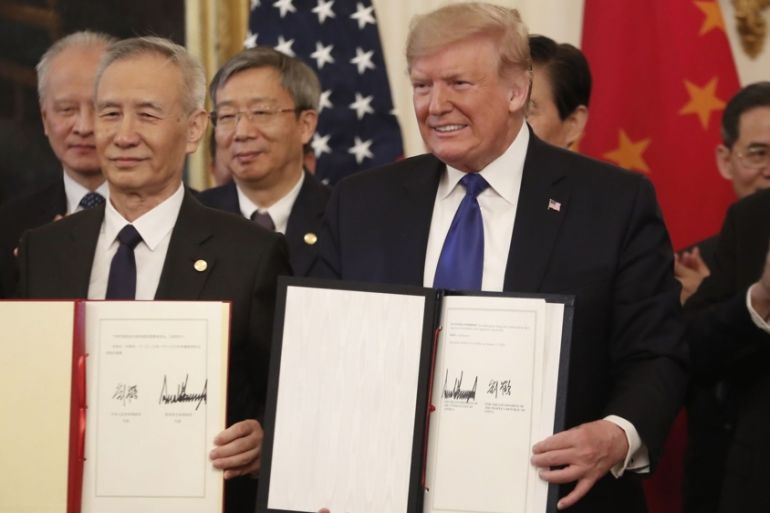By the numbers: US-China phase one trade deal
China pledged to spend more than $200bn on US goods and services, while the US lowered tariffs on Chinese imports.

On January 15, United States President Donald Trump and Chinese Vice Premier Liu He signed the long-awaited first phase of a trade agreement after both countries were locked in an 18-month trade war.
Under the initial agreement, the US lowered some of its tariffs on Chinese goods in exchange for Chinese pledges to buy more US goods and services.
Keep reading
list of 4 itemsPolitics and convenience drive Mexico to be US’s top trading partner
Will Xi and Biden mend US-China relations at the APEC summit?
UK warns of Russia laying ‘sea mines’ to deter Black Sea cargo ships
Under manufacturing products, China agreed to buy US industrial machinery, electrical equipment, pharmaceuticals, aircraft, vehicles, optical and medical instruments, iron and steel, solar-grade polysilicon, hardwood lumber, and chemical products, among others.
Its additional energy purchases include liquefied natural gas (LNG), crude oil, and metallurgical coal, while it will also spend more on financial, insurance, cloud and travel services from the US.
China will also buy more US soybeans, cotton, grains, meats, ethanol and seafood, with a pledge by China to buy an additional $5bn of agriculture products annually.
The added purchases would result in an average annual total of about $40bn, a number Trump has touted before. At the signing ceremony on Wednesday, he said China’s agricultural purchases could reach $50bn.
The 94-page document released by the office of the US Trade Representative (USTR) and China’s Commerce Ministry also saw the US lowering tariffs on $120bn worth of Chinese goods.
The goods had included Bluetooth headphones, flat-panel televisions and many types of footwear.
US tariffs of 25 percent on $250bn worth of Chinese goods will remain unchanged initially, although these remaining tariffs could be removed once the two sides conclude a phase two trade agreement, Trump said on Wednesday.
He said he did not anticipate needing to negotiate a phase three agreement.
Tariffs that were scheduled to go into effect on December 15 on nearly $160bn worth of Chinese goods, including mobile phones, laptop computers, toys and clothing, are suspended indefinitely.
China’s retaliatory December 15 tariffs, including a 25 percent tariff on US-made vehicles, have also been suspended.
Intellectual property
In the first chapter of the agreement, China agreed to strengthen legal protections for patents, trademarks and copyrights, including improved criminal and civil procedures to combat online infringement, pirated and counterfeit goods.
It contains commitments by China to follow through on previous pledges to eliminate any pressure for foreign companies to transfer technology to Chinese firms as a condition of market access, licensing or administrative approvals and to eliminate any government advantages for such transfers.
China also agreed to refrain from directly supporting outbound investment aimed at acquiring foreign technology to meet its industrial plans.
Currency
The currency agreement contains pledges by China to refrain from competitive currency devaluations and to avoid manipulating exchange rates for competitive advantage.
Any violations would be subject to the enforcement mechanism for the overall deal and could trigger tariffs.
Both countries also agreed to publish relevant data on exchange rates and external balances on a prescribed schedule.
Financial services
China agreed to improve access to its financial services market for US companies, including in banking, insurance, securities and credit rating services.
It aims to address a number of long-standing US complaints about investment barriers in the sector, including foreign equity limitations and discriminatory regulatory requirements.
China, which has pledged for years to open up its financial services sector to more foreign competition, said the deal would boost imports of financial services from the US.
Enforcement
The US and China will resolve differences over how the deal is implemented through bilateral consultations, starting at the working level and escalating to top-level officials.
If these consultations do not resolve disputes, there is a process for imposing tariffs or other penalties.
US Trade Representative Robert Lighthizer told reporters the US expected neither side would retaliate if appropriate action was taken as part of the process and following “consultation in good faith”.